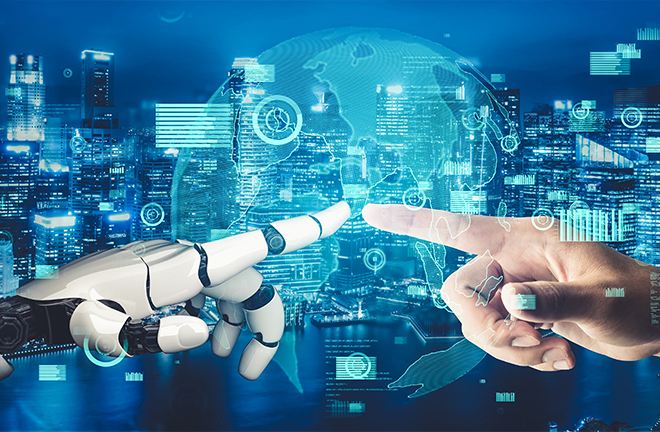Human-Machine-Environment System and new quality productive forces

Human-machine interaction Photo: Blue Planet Studio/TUCHONG
New quality productive forces not only simply enhance production efficiency but, more importantly, seek to achieve sustainable development of productivity by altering production methods, organizational structures, and relationships through innovation and technological advancements. Each sci-tech revolution brings about new social divisions of labor. As a pivotal driving force behind the current wave of sci-tech revolution and industrial transformation, artificial intelligence (AI) is widely acknowledged to have profound implications for socioeconomic development.
The contemporary form of human-machine division of labor differs from past redistributions merely based on physical or intellectual abilities. It necessitates consideration of the integration of human, machine and environmental advantages. This not only implies changes in work practices, occupational structures, and modes of thinking, but also accelerates the process of digitalization and intelligentization in various industries. With the continuous development and widespread application of AI, it can be expected that new quality productive forces will become more extensive and profound. Consequently, there is a pressing need for continuous learning and adaptation to these changes.
Generating new quality productive forces
The Human-Machine-Environment (HME) System refers to the interactive system formed by the interaction between humans and machines. It encompasses not only the process of humans using machine tools but also the influence of machines on human behaviors and the adjustments of machine behaviors made by humans. Within the HME System, there exist interactions and influences among the three factors: humans, machines, and the environment.
The development of the HME System can promote the improvement of productivity levels. The advancement of this system has led to the automation and intelligence of many tasks in the production process, greatly improving production efficiency and quality. With the development of the HME System, the demand for human labor in the production process may decrease, leading to phenomena such as human-machine substitution, thereby changing the relationship between labor and capital in the traditional production relationship. At the same time, the development of the HME System may change the status and power relations of different participants in the production process. In addition, it may give rise to new issues of property rights and distribution of benefits, necessitating the readjustment and establishment of corresponding production relations. Therefore, the development of the HME System will inevitably lead to the emergence and adjustment of new production relations.
The HME System generates new quality productive forces, with several examples as follows: the internet and e-commerce, AI, virtual reality and augmented reality. These new production tools have altered traditional work methods and production relations. With the continuous sci-tech advancement, the interaction between humans and machines will become increasingly close and complex. We can expect that the HME System will bring forth more innovation and changes.
Changing organizational structures
The introduction of new technologies often influences organizational structures, and intelligent technologies within the HME System can often mutually trigger organizational changes. Especially with technologies like AI, their introduction may spur the emergence of new organizational structures and functions.
The emergence of new organizational structures can provide an important impetus for technological development and innovation. When an organization changes its structure and working methods, it may inspire employees to devise creative solutions and encourage them to explore new technologies and approaches. New organizational structures are typically more flexible and decentralized, encouraging teamwork, communication and knowledge sharing. This open culture helps create an innovative atmosphere, stimulating employees’ creativity and innovative thinking. In addition, new organizational structures may also prioritize the intelligence of the HME System. Therefore, there exists a mutually reinforcing relationship between new organizational structures and technologies. New organizational structures can stimulate employees’ innovation and creativity, driving the development of new technologies. In turn, new technologies can provide organizations with more opportunities for innovation and development, further promoting the evolution of organizational structures.
Leveraging multiple entities
Relevant government departments should formulate policies and regulations to protect personal privacy and data security while promoting the sustainable development of AI. They should also allocate funds to support AI research and innovation and provide training and educational resources to ensure that everyone in society can benefit from the development of AI. Related enterprises should also actively adapt to the development of AI, investing in, researching, developing and applying AI technologies to improve productivity and competitiveness. At the same time, they should proactively consider the impact of AI on jobs and employees, actively supporting career transition and training to adapt to new job requirements. Additionally, they should prioritize data security and privacy protection to ensure the legal, compliant and responsible use of AI technologies.
Individuals, facing the wave of AI development, should pay attention to the application areas and development trends of AI and continuously enhance their skills and knowledge through lifelong learning to adapt to the new working environment. They should also maintain an open mind, be willing to embrace new technologies and changes, and actively participate in social discussions and decision-making to ensure that the development of AI is in line with human benefits and values.
The mindset embodied by the HME System emphasizes a systemic, holistic, and interactive approach. It recognizes the interdependence and mutual influence among humans, machines, and the environment, emphasizing the need to consider them as a whole rather than as separate entities. This holistic thinking, rooted in the Eastern logistic thinking, holds significant potential and prospects for applications in scientific research, engineering design, and social management. By adopting this holistic logic in various fields, it can continuously generate new quality productive forces.
Liu Wei is director of the Human-Computer Interaction and Cognitive Engineering Laboratory at Beijing University of Posts and Telecommunications.
Edited by ZHAO YUAN

 PRINT
PRINT CLOSE
CLOSE